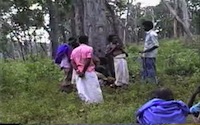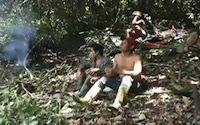The Wichí live in the Chaco region. The settlements are distributed in
three Argentine provinces: northern Chaco, middle and western Formosa,
and eastern Salta; as well as in southern Bolivia on the Pilcomayo
River. It is a multiethnic area with a current indigenous population of
approximately 170,000.
Rodríguez Mir and Braunstein (1993/94) studied the settlement and
sedentarization processes of these groups. Nowadays, the distribution
of the settlements responds largely to the groups’ control of the
territory when they were nomads. The research has been carried out in
two settlements located in the center of Formosa -Tres Pozos and
Lakhawichi.
The settlements resulted from the dispersal of the groups that were
reunited in 1930 without taking into account any distinctions between
sub-groups at the “Francisco Javier Muñiz” reservation. These groups
had previously settled in areas near Route 81 and the railroad tracks
-built between 1908 and 1931- which connected the city of Formosa with
Embarcacion in the province of Salta. They were attracted by the
opportunity of employment and the possibility of doing trade with the
populations that arose with the arrival of the train. Some Wichí
inhabited areas within their places of origin and which now make up the
settlements of Lakhawichi, Tres Pozos, Pozo del Mortero, and Laguna
Yema. Likewise, owing to their growing dependence on the Creoles in the
city of Las Lomitas for food staples and temporary jobs, as well as the
depletion of natural resources by White colonists, various families
moved closer to Las Lomitas and established the periurban settlement of
La Pantalla. A Civil Association has been created in each of these
settlements and holds the land titles on which they are living.







